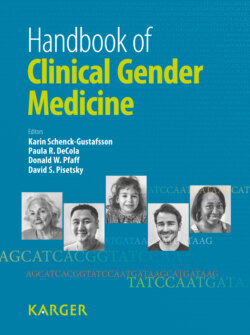Читать книгу Handbook of Clinical Gender Medicine - Группа авторов - Страница 94
На сайте Литреса книга снята с продажи.
Clinical Allostatic Load Index Formula
ОглавлениеThe AL index is thus far a research index with the promising possibility of becoming a clinical tool. It must therefore become accessible to medical professionals [10]. In this endeavor, the following shall demonstrate a simple formulation to calculate an AL index based on clinical reference ranges used routinely for diagnostic purposes. For each biomarker value included, a subclinical cutoff can be easily calculated based on normative clinical ranges.
Fig. 2. Frequencies of biomarkers repeatedly included in approximately 60 AL studies conducted between 1997 and 2010. TC = Total cholesterol; HDL = high-density lipoprotein; LDL = low-density lipoprotein.
Let us consider, as an example, total cholesterol levels with a normal range of 3.3-5.2 nmol/l. First, to determine the range, subtract the lower limit from the upper limit (5.2-3.3 = 1.9). Next, to determine the quartile, divide the range by four (1.9/4 = 0.475). Finally, to determine the cutoff, either subtract the quartile from the upper limit for the upper cutoff (5.2-0.475 = 4.725) or add the quartile to the lower limit for the lower cutoff (3.3 + 0.475 = 3.775) in the case of biomarkers like HDL cholesterol, DHEA-S, and albumin, whereby lower levels denote danger. Based on this example, a patient with total cholesterol at 4.725 nmol/l or higher would get a score of ‘1’ while values below this cutoff would be scored as ‘0’. A clinical AL index is therefore the sum of subclinically dysregulated biomarkers for each individual. Our previous work found that a clinical AL index was associated with increased subjective reports of chronic stress, frequency of burnout symptoms, and hypocortisolemic profiles characteristic of fatigue states [11]. While this formulation is designed for medical practice, it does not yield cutoffs that are exceedingly different from those based on biomarker distributions based on sample distributions generally used in empirical AL studies summarized in the following section.
